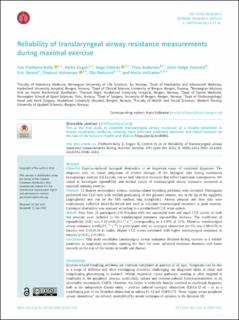| dc.contributor.author | Fretheim-Kelly, Zoe | |
| dc.contributor.author | Engan, Mette | |
| dc.contributor.author | Clemm, Hege Synnøve Havstad | |
| dc.contributor.author | Andersen, Tiina Maarit | |
| dc.contributor.author | Heimdal, John-Helge | |
| dc.contributor.author | Strand, Eric | |
| dc.contributor.author | Halvorsen, Thomas | |
| dc.contributor.author | Røksund, Ola Drange | |
| dc.contributor.author | Vollsæter, Maria | |
| dc.date.accessioned | 2022-09-01T11:00:40Z | |
| dc.date.available | 2022-09-01T11:00:40Z | |
| dc.date.created | 2022-03-15T16:27:00Z | |
| dc.date.issued | 2022 | |
| dc.identifier.citation | ERJ Open Research. 2022, 8(1), Artikkel 00581-2021. | en_US |
| dc.identifier.issn | 2312-0541 | |
| dc.identifier.uri | https://hdl.handle.net/11250/3015098 | |
| dc.description | This version is distributed under the terms of the Creative Commons Attribution Non-Commercial License 4.0. | en_US |
| dc.description.abstract | Objective: Exercise-induced laryngeal obstruction is an important cause of exertional dyspnoea. The diagnosis rests on visual judgement of relative changes of the laryngeal inlet during continuous laryngoscopy exercise (CLE) tests, but we lack objective measures that reflect functional consequences. We aimed to investigate repeatability and normal values of translaryngeal airway resistance measured at maximal intensity exercise.
Methods: 31 healthy nonsmokers without exercise-related breathing problems were recruited. Participants performed two CLE tests with verified positioning of two pressure sensors, one at the tip of the epiglottis (supraglottic) and one by the fifth tracheal ring (subglottic). Airway pressure and flow data were continuously collected breath-by-breath and used to calculate translaryngeal resistance at peak exercise. Laryngeal obstruction was assessed according to a standardised CLE score system.
Results: Data from 26 participants (16 females) with two successful tests and equal CLE scores on both test sessions were included in the translaryngeal resistance repeatability analyses. The coefficient of repeatability (CR) was 0.62 cmH2O·L−1·s−1, corresponding to a CR% of 21%. Mean±sd translaryngeal airway resistance (cmH2O·L−1·s−1) in participants with no laryngeal obstruction (n=15) was 2.88±0.50 in females and 2.18±0.50 in males. Higher CLE scores correlated with higher translaryngeal resistance in females (r=0.81, p<0.001).
Conclusions: This study establishes translaryngeal airway resistance obtained during exercise as a reliable parameter in respiratory medicine, opening the door for more informed treatment decisions and future research on the role of the larynx in health and disease. | en_US |
| dc.language.iso | eng | en_US |
| dc.subject | exertional dyspnoea | en_US |
| dc.subject | laryngeal obstruction | en_US |
| dc.subject | maximal intensity exercise | en_US |
| dc.subject | translaryngeal airway resistance | en_US |
| dc.title | Reliability of translaryngeal airway resistance measurements during maximal exercise | en_US |
| dc.type | Peer reviewed | en_US |
| dc.type | Journal article | en_US |
| dc.description.version | publishedVersion | en_US |
| dc.rights.holder | © The authors 2022 | en_US |
| dc.source.pagenumber | 9 | en_US |
| dc.source.volume | 8 | en_US |
| dc.source.journal | ERJ Open Research | en_US |
| dc.source.issue | 1 | en_US |
| dc.identifier.doi | 10.1183/23120541.00581-2021 | |
| dc.identifier.cristin | 2010022 | |
| dc.description.localcode | Institutt for idrettsmedisinske fag / Department of Sports Medicine | en_US |
| dc.source.articlenumber | 00581-2021 | en_US |
| cristin.ispublished | true | |
| cristin.fulltext | original | |
| cristin.qualitycode | 1 | |
